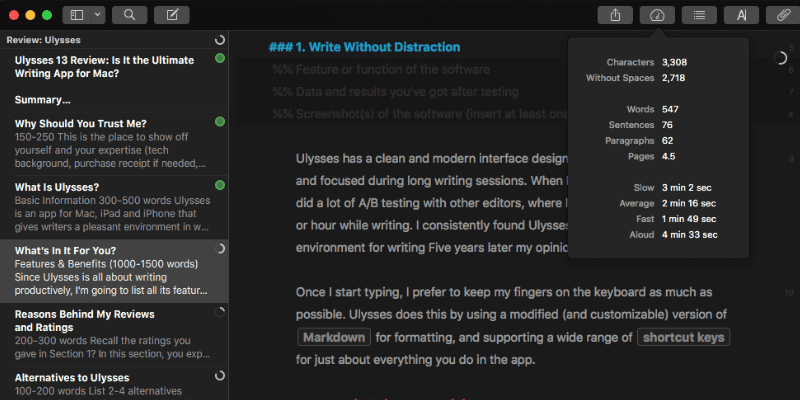
Ulysses
Summary
Writing is a multi-faceted process that includes brainstorming, research, writing, revision, editing, and publishing. Ulysses has all the features to take you from beginning to end and does so in a way that is pleasurable and focused.
Personally, over the last five years, I’ve found the app to be an effective writing tool, and it has become my favorite. It helps me to stay focused on my writing tasks better than other apps, and I’ve come to appreciate and rely on the combination of a minimal interface, the use of Markdown, the ability to use a number of sheets to rearrange an article, and excellent library and publishing features.
It’s not the only option out there, and if you use Windows, avoid subscriptions, or despise Markdown, one of the other apps will suit you better. But if you’re a serious Mac-based writer after an effective tool, give it a go. I recommend it.
What I Like: Streamlined interface keeps you writing once you start. Helpful tools stay out of the way until needed. Library syncs your work to all your devices. Easy publishing in a number of formats.
What I Don’t Like: Not available for Windows. Subscription pricing does not suit everyone.
Is Ulysses app free?
No, Ulysses is not free, but a free 14-day trial of the app is available on the Mac App Store. To continue using it after the trial period you need to pay for it.
How much does Ulysses cost?
$5.99/month or $39.99/year. One subscription gives you access to the app on all of your Macs and iDevices.
The move to a subscription model was somewhat controversial. Some people are philosophically opposed to subscriptions, while others are concerned about subscription fatigue. Because subscriptions are ongoing costs, it doesn’t take too many until you reach your financial limit.
I would personally prefer to pay for the app outright, and did so several times, for the Mac then iOS versions of the app. But I’m not absolutely opposed to paying subscriptions, but only do so for apps I can’t do without.
So I didn’t subscribe to Ulysses right away. The previous version of the app that I paid for was still working, and the new version didn’t offer any additional features. In the ten months since then, I’ve continued to use Ulysses while evaluating the alternatives. I concluded that Ulysses was still the best app for me, and have watched the company continue to improve it.
So I subscribed. In Australia, a subscription costs AU$54.99/year, which is only a little over a dollar a week. That’s a small price to pay for a quality tool that enables me to make a living and is a tax deduction. For me, the price is totally justified.
Is Ulysses for Windows?
No, Ulysses is only available for Mac and iOS. There is no Windows version available, and the company has not announced any plans to create one, though they’ve hinted a few times that they may consider it one day.
There is an app called “Ulysses” for Windows, but it’s a shameless rip-off. Don’t use it. Those who purchased it reported on Twitter that they feel they were misled.
The Windows version is in no way associated to us – unfortunately, it’s a shameless rip-off.
— Ulysses Help (@ulyssesapp) April 15, 2017
Are there any tutorials for Ulysses?
There are a number of resources available to help you learn how to use Ulysses effectively. The first one you’ll notice is the Introduction Section in Ulysses. This is a number of groups (folders) in the Ulysses library that contain explanations and tips about the app.
The sections included are First Steps, Markdown XL, Finder Details and Shortcuts and Other Tips.
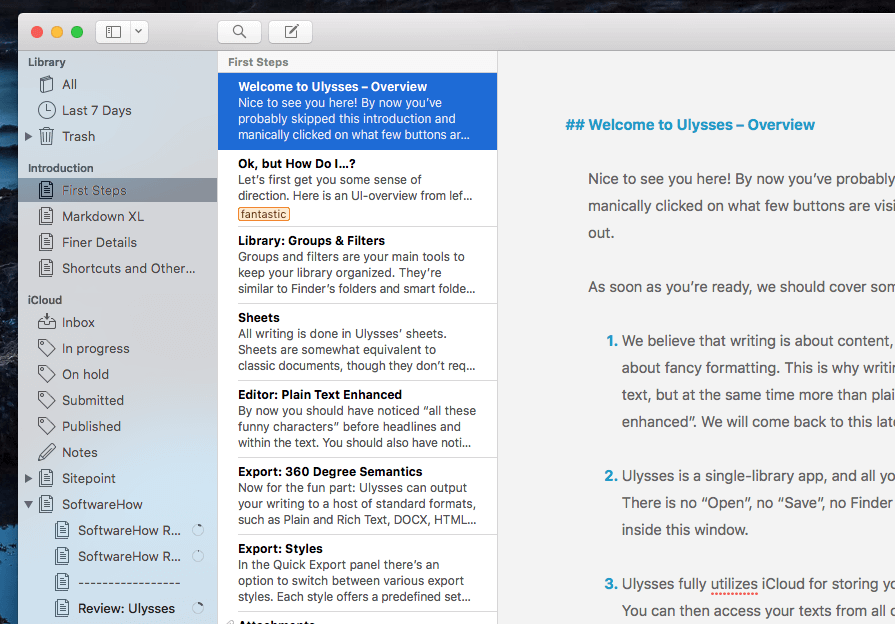
You can get all of Ulysses’ shortcut keys. It covers how to make the most of Ulysses, as well as how to use it to structure a book into parts and scenes and manage your research.
Table of Contents
Why Trust Me for This Review
My name is Adrian, and writing has been a big part of my life for as long as I can remember. At first, I used pen and paper, but I’ve been typing my words on computers since 1988.
Writing has been my main occupation since 2009, and I’ve used a number of apps along the way. They include online services like Google Docs, text editors like Sublime Text and Atom, and note-taking apps like Evernote and Zim Desktop. Some have been good for collaboration, others come with useful plugins and search features, while others let write for the web directly in HTML.
I bought Ulysses with my own money on the day it was released, way back in 2013. Since then I’ve used it to write 320,000 words, and although I’ve looked, haven’t found anything that suits me better. It might suit you too, but we’ll also cover a few alternatives in case it doesn’t meet your preferences or needs.
Detailed Review of Ulysses Writing App
Ulysses is all about writing productively, and I’ll list its features in the following five sections. In each subsection, I’ll explore what the app offers and then share my personal take.
1. Write Without Distraction
Ulysses has a clean, modern interface to keep you comfortable and focused during long writing sessions. When I first started to use the app, I did a lot of A/B testing with other editors, where I switched apps every half hour or so while writing. I consistently found Ulysses the most pleasant environment to write in. Five years later my opinion hasn’t changed.
Once I start typing, I prefer to keep my fingers on the keyboard as much as possible. Ulysses allows this by using a modified (and customizable) version of Markdown for formatting and supporting a wide range of shortcut keys for just about everything you do in the app. If you prefer using a mouse, Ulysses makes that easy too.
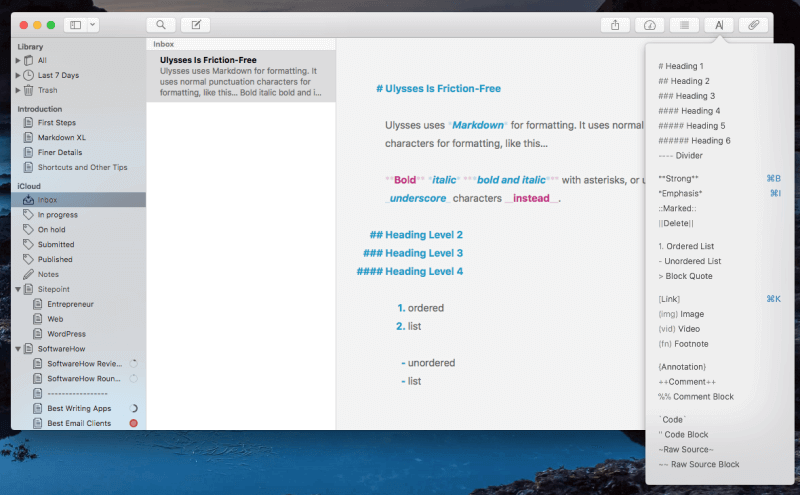
The app allows me to focus on the content I’m creating rather than the interface I’m creating it in. Dark mode, typewriter mode, fullscreen mode and minimal mode all help with this.
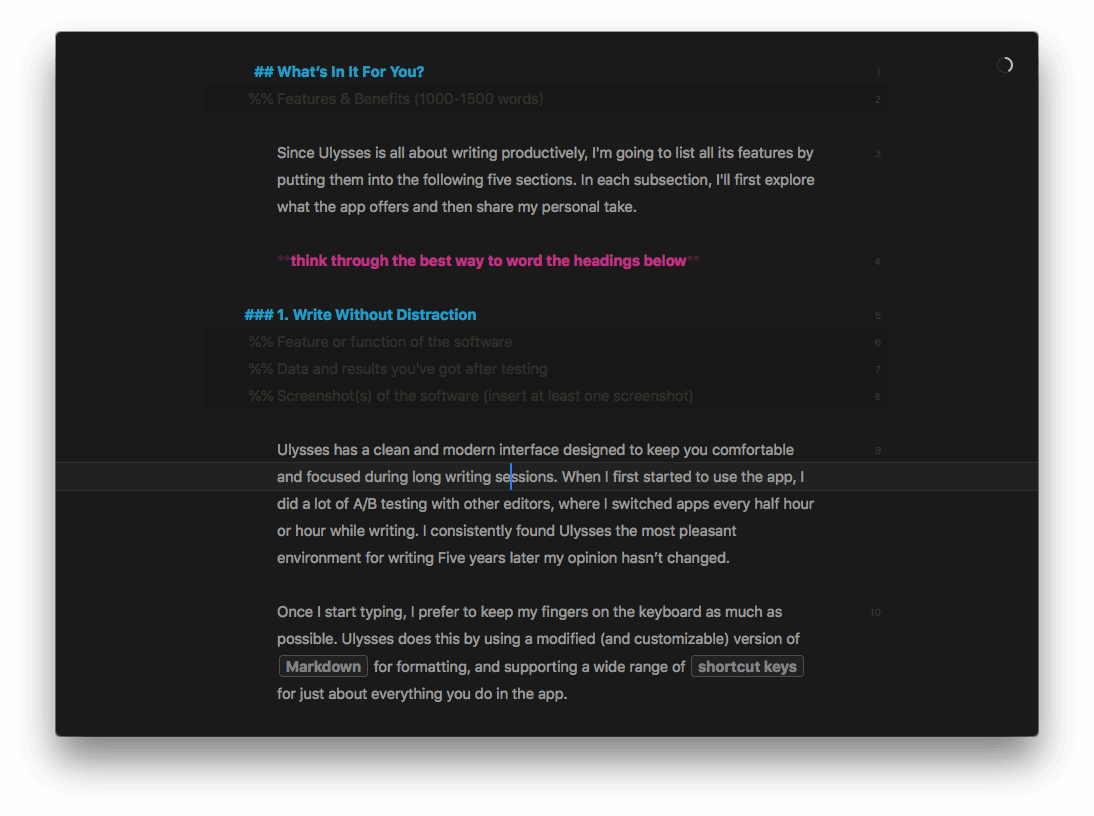
Once I am working in the writing view of the app, I can show or hide additional panes by swiping left or right with two fingers (or just one finger on iOS).
Besides typing just text, I can add comments by typing %% (for full paragraph comments) or ++ (for inline comments), and even create sticky notes that pop up just by surrounding the text in curly brackets. If I forget some Markdown syntax, it’s all available in drop-down menus.
For technical writing, Ulysses provides code blocks with syntax highlighting. The highlighting is preserved on export, as shown in this image from a Ulysses tutorial.
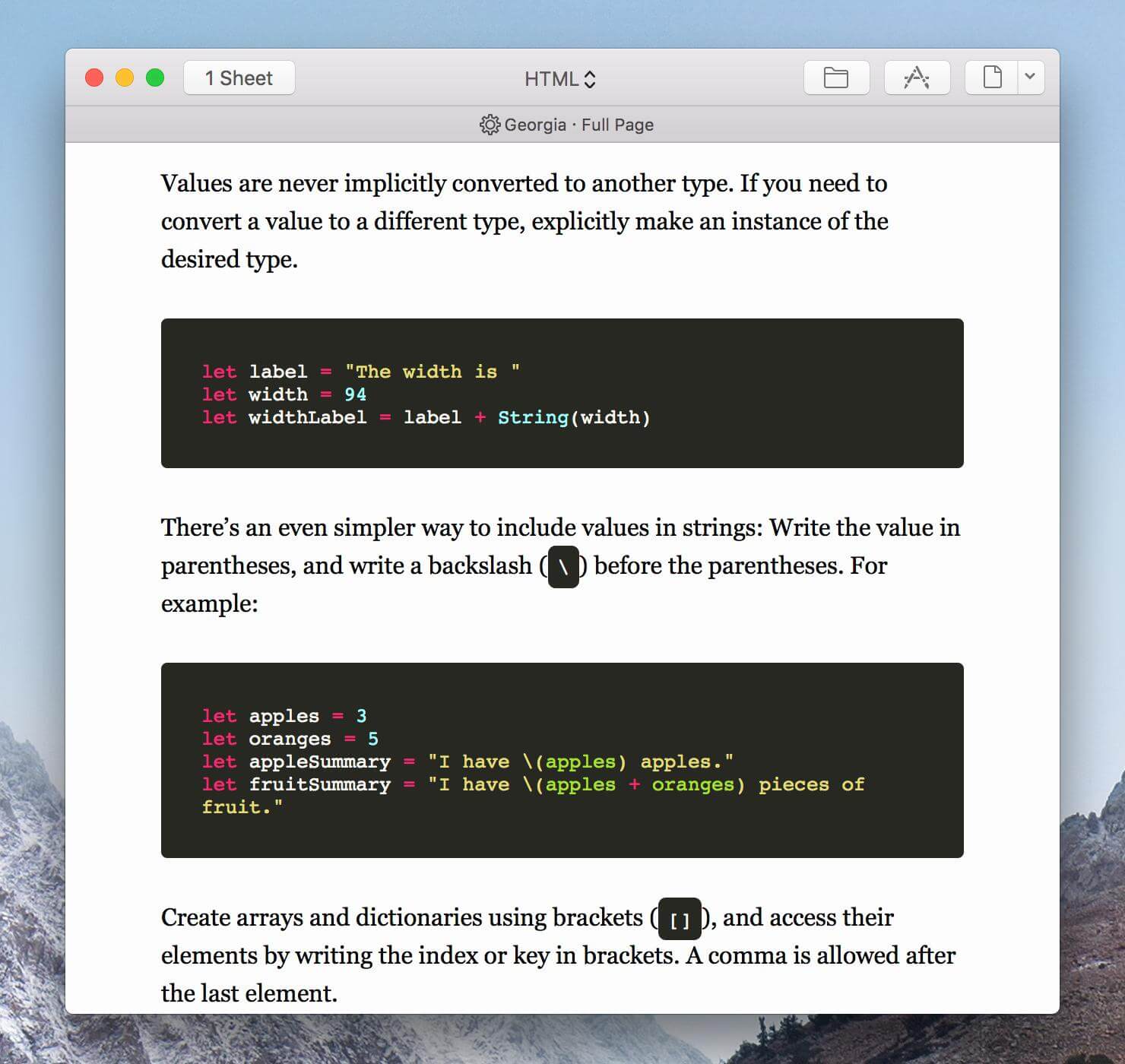
My personal take: I love writing in Ulysses. The combination of Markdown, a minimal interface, and distraction-free features make me more productive.
2. Access Useful Writing Tools
Ulysses looks so simple that it’s easy to miss all of the power under the hood. And that’s the way it should be. I don’t want lots of writing tools cluttering up the interface as I write, but I do want them immediately available whenever I need them.
First, the macOS spell check and grammar check can be turned on while you type, or run manually. Live document statistics are also available by clicking a toolbar icon.
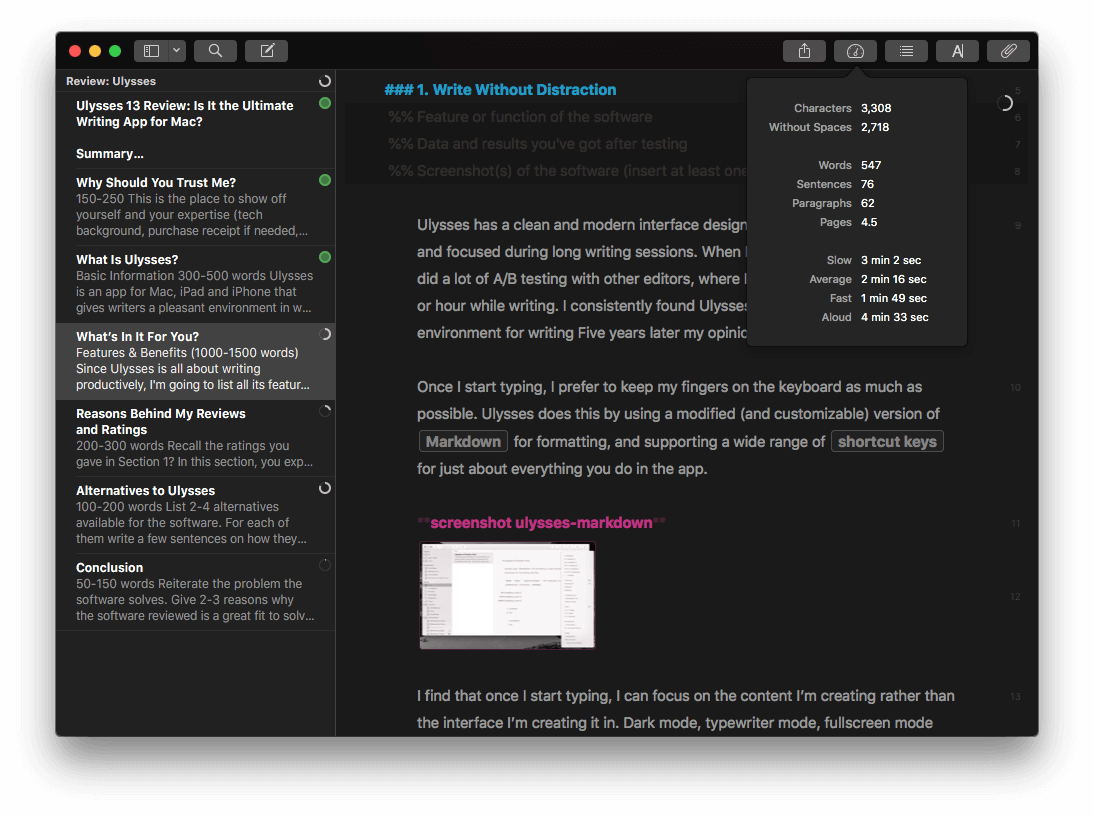
The attachments window gives you access to additional tools, including keywords, goals, notes, and images.
Keywords are basically tags, and we’ll talk more about them later in the review. I find goals very useful. While a word count lets you see how many words you have typed, a goal specifies how many words you are aiming for, and gives immediate feedback on your progress.
I set word goals for each section of this review, and you’ll notice in the image above that the sections where I’ve reached that goal are marked with green circles. The sections I’m still working on have a circle segment that indicates my progress. Too many words and the circle turns red.
Goals are highly configurable, and as of the current version (Ulysses 13), deadlines (time-based goals) can also be defined, and the app will tell you how many words you need to write each day to meet the deadline. The screenshot below will give you an indication of some of the options.
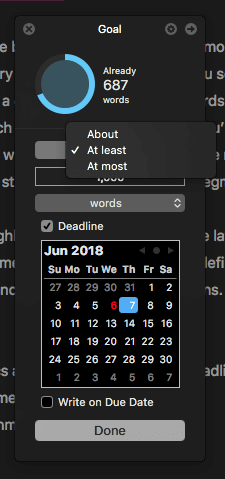
Finally, note and image attachments are an effective way of keeping track of references for the piece you are writing. I’ll often jot a few thoughts in an attached note — though I’m just as likely to type it into the body of the article — and I attach web pages and other reference information as PDFs. You can also paste the URLs of web resources into the attached text notes.
My personal take: I rely on goals and statistics every time I write. I love the instant feedback I get on my progress as, section by section, the circles turn green. I find notes and attachments helpful too, and after five years still find myself discovering new ways to use the app.
3. Organize & Arrange Your Content
Ulysses provides a single library for all your texts that is synced via iCloud onto all of your Macs and iDevices. Additional folders from your hard drive can also be added to Ulysses, including Dropbox folders. It’s flexible and works well. It’s also pain-free. Everything is saved automatically and backed up automatically. And full version history is retained.
Rather than dealing with documents, Ulysses uses “sheets”. A long writing project can be made up of a number of sheets. That allows you to work on one piece of the puzzle at a time, and easily rearrange your content by dragging a sheet to a new position.
This review, for example, is made up of seven sheets, each with its own word count goal. Sheets can be reordered as you like, and don’t have to be sorted alphabetically or by date. When you’ve finished writing, just select all of the sheets and then export.
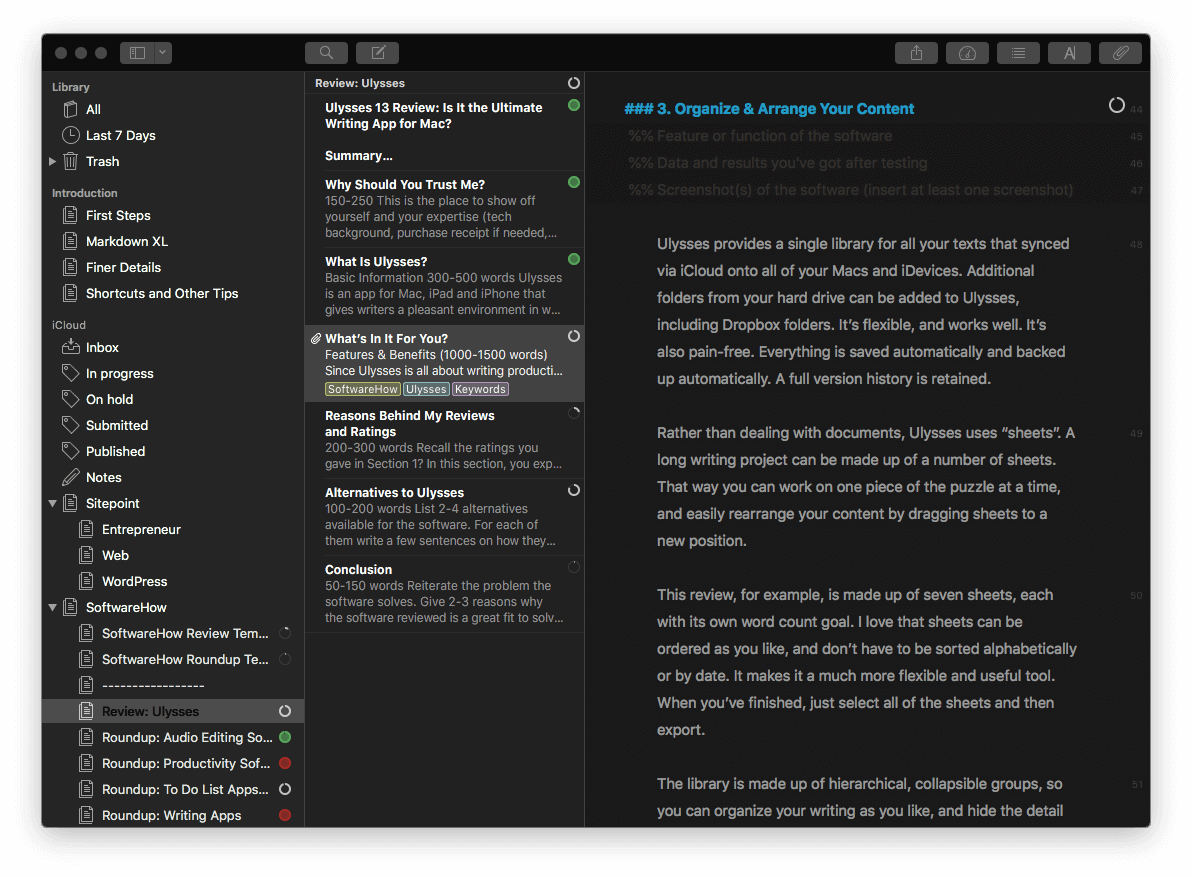
The library is made up of hierarchical, collapsible groups (like folders), so you can organize your writing into different containers, and hide the detail you don’t need to see right now. You can also create filters, which are essentially smart folders, and we’ll look at those more closely in the next section.
Finally, you can mark sheets as “Favorites”, which are collected in one place near the top of your library, and also add keywords to sheets and groups. Keywords are essentially tags, and another way to organize your writing. They are not automatically displayed in your library but can be used in filters, as we’ll demonstrate below.
My personal take: Ulysses lets me work anywhere, because everything I’m working on now, and everything I’ve written in the past, is organized in a library that is available on all of my computers and devices. The ability to split up a large writing project across a number of sheets makes the job more manageable, and the combination of groups, keywords, and filters allows me to organize my work in a variety of ways.
4. Search for Documents & Information
Once you build up a significant body of work, search becomes important. Ulysses takes search seriously. It integrates well with Spotlight, and provides a slew of other search features, including Filters, Quick Open, library searches, and find (and replace) within the current sheet.
I love Quick Open, and use it all the time. Just press command-O and start typing. A list of matching sheets is displayed, and pressing Enter or double-clicking takes you straight there. It’s a convenient way to navigate your library.
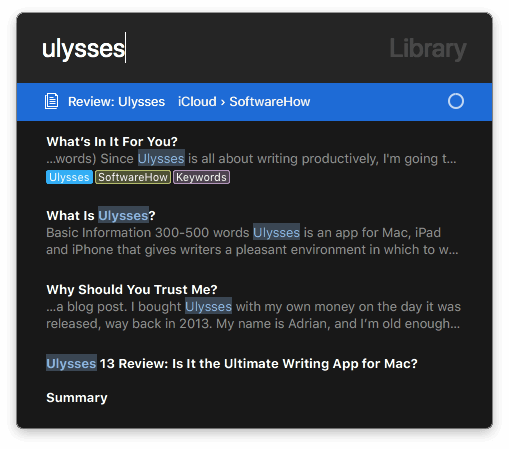
Find (command-F) allows you to search for text (and optionally replace it) within the current sheet. It works the same as it does in your favorite word processor.
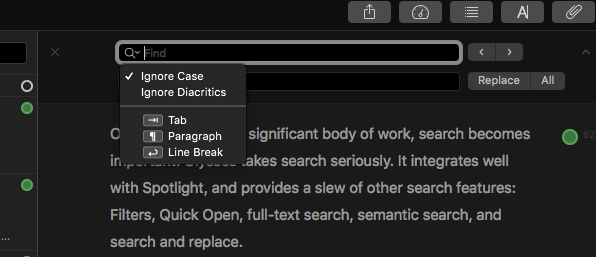
Search in Group (shift-command-F) lets you search your current group. To search your entire library, navigate to Library > All first. It’s a powerful feature, allowing you to search for text, formatting, keywords, headings, notes and more.
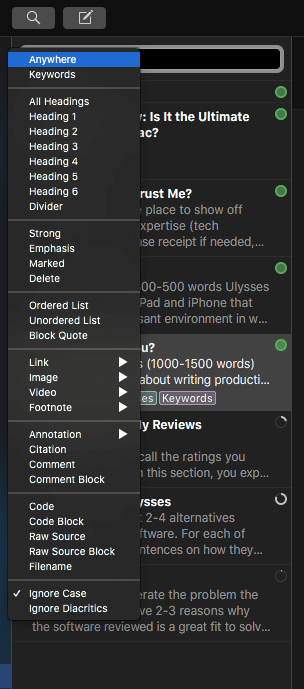
And finally, Filters allow you to place group searches permanently in your library as smart folders. I use them to keep track of keywords like “In progress”, “On hold”, “Submitted” and “Published” so I can quickly find articles at various stages of completion.
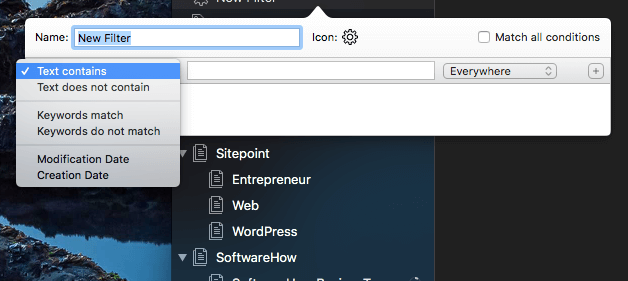
Filters are more powerful than the other methods of searching because you can specify more than one criterion for the search, including dates. They are also handy because they are permanently located in your library, so you just need to click on the filter rather than manually do a search each time.
My personal take: Quick Open and Filters are additional ways to navigate your library using search. Besides these, powerful search features within a document and across your documents are also available.
5. Export & Publish Your Work
Completing a writing assignment is never the end of the job. There’s often an editorial process, and then your piece needs to be published. And today there are a lot of ways to publish content!
Ulysses has an excellent publishing feature that’s quite easy to use. It will let you publish directly to WordPress and Medium, either as a published post or as a draft. It will let you export to Microsoft Word so your proofreaders and editors can work on your document with track changes enabled. And it will allow you to export to a whole range of other useful formats, including PDF, HTML, ePub, Markdown, and RTF.
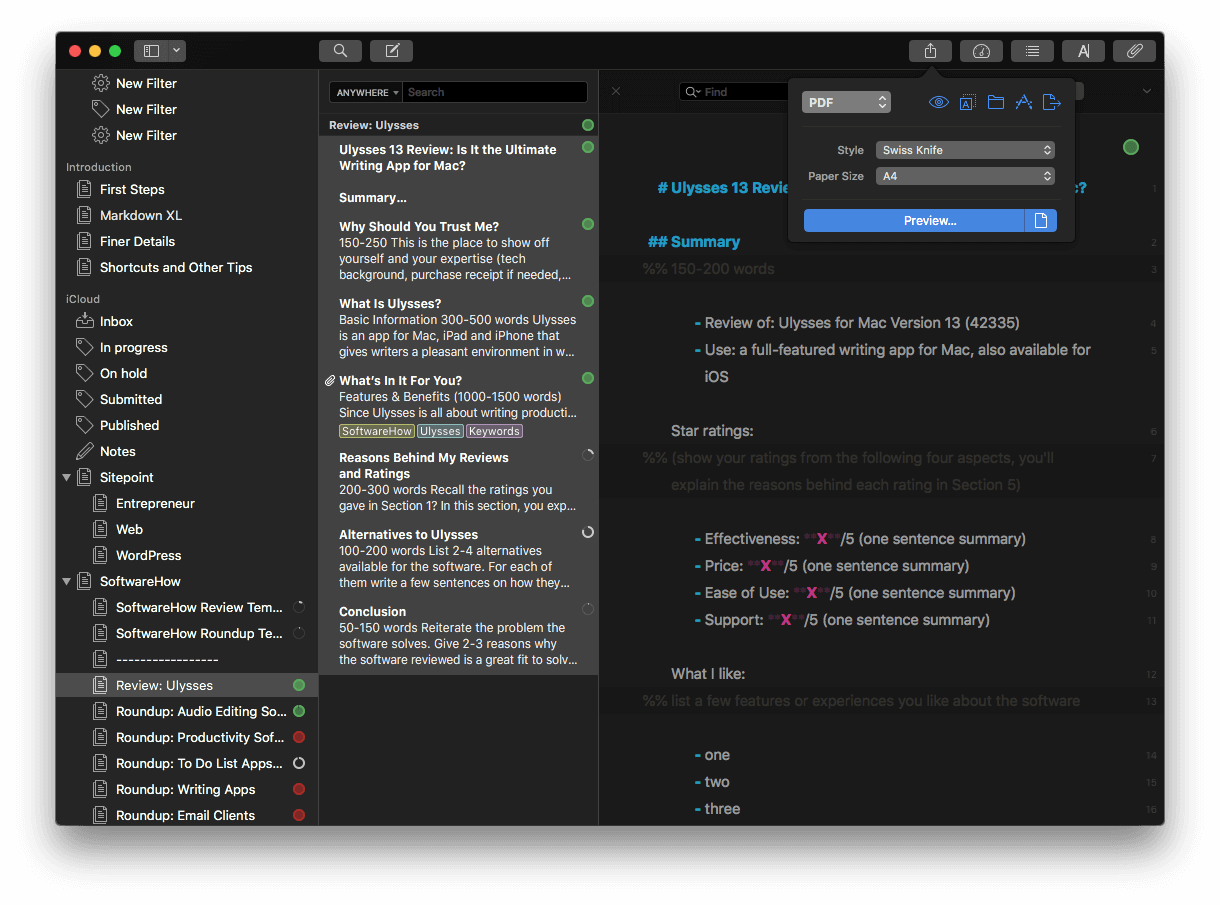
You can preview the export within the app, and you can export to the clipboard rather than a file. That way you can, say, export as HTML straight to the clipboard, and paste the result into a WordPress text window.
Quite a number of export styles are built into Ulysses, and even more are available from the style exchange. That gives you a lot of options for the final look of your document.
My personal take: I appreciate that while I’m writing in Ulysses, I don’t have to think of the final format of the document. I just write. Once I’m finished, Ulysses is able to create a wide range of document formats in a variety of styles, or just place my article on the clipboard for pasting in WordPress, Google Docs, or elsewhere.
Reasons Behind My Ratings
Features: 5/5
Ulysses includes everything an Apple user needs to write: brainstorming and research, writing and editing, keeping track of word count goals and deadlines, and publishing. Each of these jobs is done effectively and economically. No effort is wasted, and whether you prefer to keep your hands on the keyboard or use a mouse, the app lets you work the way that suits you best.
Pricing: 4/5
Ulysses is a premium product for professional writers and doesn’t come at a bargain basement price. I feel that the price is justified for serious writers, and I’m not alone, but those looking for an inexpensive, casual tool should look elsewhere. The decision to charge a subscription was a controversial one, and if that’s a problem for you, we’ll list some alternatives below.
Ease of Use: 5/5
Ulysses is so easy to use that it’s hard to believe there’s so much power under the hood. The app is easy to get started with, and you can learn additional features as you need them. There are often multiple ways to achieve the same function, and the app can adapt to your preferences. For example, you can bold text using Markdown formatting, clicking an icon, and also the familiar control-B.
Support: 5/5
In five years I’ve never had the need to contact Ulysses support. The app is reliable, and the provided reference material is helpful. The team seems very responsive and proactive on Twitter, and imagine they would be the same way for any support issues. You can contact support via email or an online form.
Final Verdict
Ulysses claims to be “the ultimate writing app for Mac, iPad and iPhone”. Is it really the best in class? It’s an app designed to help writers do their job without distraction, with all the tools and features they need to take their project from concept to published work, whether it’s a blog post, training manual, or book. It’s not a word processor with a host of unnecessary features, nor a simple text editor. Ulysses is a complete writing environment.
The app is available for both macOS and iOS, and the document library syncs effectively between all of your devices. You could start your writing on your Mac, add a few thoughts on your iPhone as they occur to you, and edit your text on your iPad. The app allows you to work anywhere, anytime… as long as you live within the Apple ecosystem. We’ll list some Windows alternatives near the end of our review.
If you’re a Mac user, you already have Pages and Notes. You may have even installed Microsoft Word. So why would you need another app to type your thoughts? Because they’re not the best tools for the job. None of those apps have considered the entire writing process, and how to help you through it. Ulysses has.

I like the sound of Ulysses. But using several word processors over the years I’ve had problems with layout – line spacing, font size etc. I just need to get the text on paper. As more features are added, the slower the progress from my point of view. I’m probably just dumb. But in the days when I used an electronic typewriter, I seemed to have far less trouble getting my books finished. I read somewhere that Robert Ludlum used to write his books in longhand on paper with a soft lead pencil – 2B or similar. They were very good thrillers. Perhaps all the fiddling about with fancy doodads needed just to include a phrase in italics or something is sapping my vital juices. “Nil desperandum” might be a good motto for all aspiring authors, whatever their Word Pro. Or maybe I’m just and angry ageing man. Maybe I have always been an ageing angry something, from eleven years upwards. Oh, well. Nil deperandum. If you can manage it.
Thanks for your feedback, Derek. “I like the sound of Ulysses. But…” That “but” isn’t needed! Ulysses doesn’t do layout or add unnecessary features that slow the app down. There are no fancy doodads to fiddle with just to add italics. It’s a lot like the electronic typewriter you mention, and I love it. Maybe it’s the perfect app for you!
Thanks Adrian for your comments. I am giving Ulysses a whirl after trying Scrivener and failing. (So many bells and whistles – impressive and no doubt useful, but frustrating when all I wanted was a straight answer to what I think is a simple question. For example: I wanted to, needed to, change the name of my PROJECT. I never managed to do it. Nor could I delete the damned thing. However, as I have said elsewhere, I am just a dumb son of a whatsis. Mea culpa, or words to that effect.) Now then, Ulysses is certainly easier to get into once one has found a well-planned tutorial. So, thanks a million, Adrian. I mean it.
Thanks, Derek. Feel free to report back with how Ulysses worked for you.
I don’t see anything about Tables of Contents linking, Bibliographies or Indexing tools. Without those tools, iPages, iAuthor, Ulysses and Scrivner are all just fancier typewriters. Nothing more.
I would be very happy to participate if the functions I’ve listed above are available and come with support so I don’t have to spend a year learning how to use them.